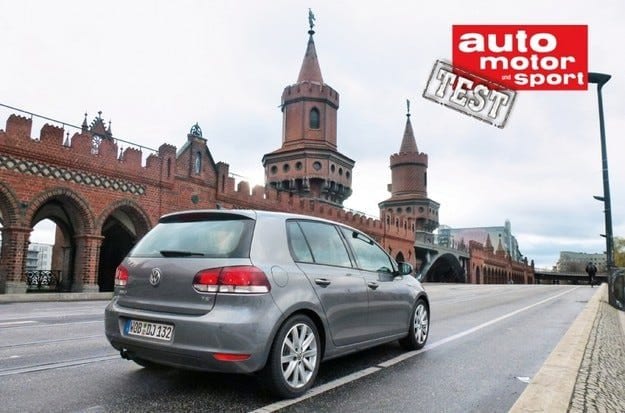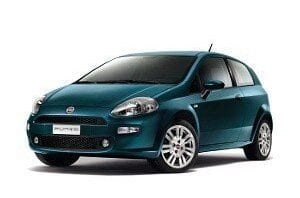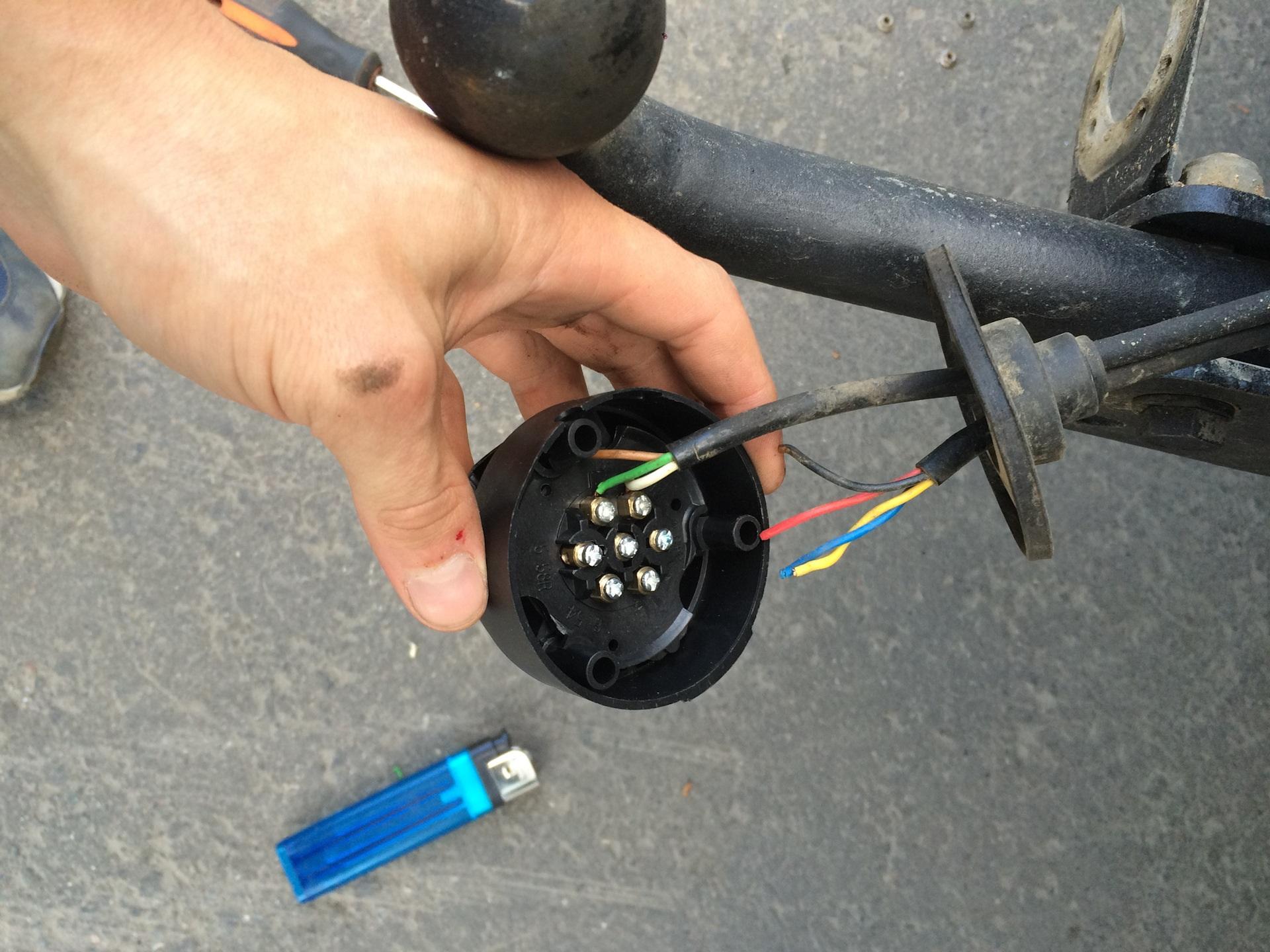
Тест драйв VW Golf: 100 километров

Достаточно ли прочен современный привод? А все остальное — тоже?
Эмоциональное сияние VW Golf больше похоже на ведущего серьезных новостей, чем на остроумного ведущего. Спонтанные аплодисменты? К шестому поколению их уже нет; Гольф должен работать — и все. Однако когда с сентября 2009 года прошел тестовый Гольф с двигателем TSI и мощностью 122 л.с. поселился навсегда на одном из мест на редакционной стоянке, на его довольно неприглядный лак с цветом United Grey лился град слишком эмоциональных комментариев. Причина — трюфельно-коричневые кожаные сиденья, которые бросались в глаза из-за окон как шикарный контрастный воротник рубашки и торчащие из-под серого свитера манжеты. Крайне редко вечный герой компактного класса так элегантно одет.
В списке опций
Поскольку кожаная обивка доступна только в сочетании с очень удобными спортивными сиденьями, VW просит за это доплату 1880 евро. А если уж на то пошло, то семиступенчатая коробка передач с двойным сцеплением, люк, ксеноновые фары, навигационная система и адаптивные амортизаторы тестового автомобиля незаметно подняли его цену до внушительных 35 625 евро, что тоже вызвало оживленные дискуссии.
Можно согласиться с тем, что лишь небольшое количество представителей модели имеют возможность так бесконтрольно грести из сумки с аксессуарами, но многие покупатели по-прежнему позволяют себе ту или иную привлекательную добавку. Они, вероятно, задаются вопросом, продолжает ли камера заднего вида надежно работать под логотипом VW даже после 100 километров. А сможет ли активный помощник по парковке загнать машину в любую щель? Коробка передач DSG продолжает переключаться так же проворно, как в день покупки?
Самая главная вещь
Во-первых, в салоне царила впечатляющая тишина, в частности, за счет необычайно плавной работы турбомотора. Читатель Томас Шмидт сначала даже пытался «заводить на каждом светофоре» свой Golf с таким же двигателем, потому что на холостом ходу четырехцилиндровый агрегат практически бесшумен. К тому же блок непосредственного впрыска оказался крайне темпераментным — качество, которое еще не присуще стандартным двигателям этого класса мощности. Здесь 1,4-литровый двигатель играет козла принудительной заправки, что обеспечивает ему максимальный крутящий момент 200 ньютон-метров при низких 1500 об / мин.
Правда, разгоняясь с места до 100 км / ч за 10,2 секунды, тестовая машина отставала от заводских данных на 9,5 секунды, но на нехватку мощности никто не жаловался. Однако на 71 километрах несколько лошадиных сил, казалось, утонули в водах Боденского озера, возле которого в то время двигался наш Golf. Подсветка контрольного индикатора выхлопа вынудила нас посетить сервис вне графика, и там диагностировали неисправность рычагов, управляющих турбонагнетателем. Лечение потребовало замены блока на новый — не потому, что турбина была повреждена, а потому, что для снижения производственных затрат неисправные компоненты уже были неотъемлемой частью конструкции турбокомпрессора и должны были быть полностью заменены. Ремонт обошелся почти в 511 евро и покрывался гарантией, но после стольких километров он принес пользу очень немногим клиентам.
Всегда в пути
Отдельные владельцы Golf также сообщали о проблемах с технологией форсирования двух вариантов 1.4 TSI мощностью 122 и 160 л.с. Однако завод-изготовитель не забирал автомобили в сервис, так как соответствующие поломки возникали очень редко. Несмотря на досадную аварию, участнику Гольф-марафона не пришлось добираться до СТО с помощью посторонних, что положительно отражается на балансе дефектов. Поэтому мы отказались и упомянули кое-что, что нам нужно было сказать только в конце, чтобы поддерживать давление — тем более, что некоторые коллеги опасались проблем с семиступенчатой коробкой передач с двойным сцеплением из-за ее чрезвычайно сложной конструкции.
Действительно, с самого начала многие водители жаловались на грубый запуск и удары в силовом тракте при маневрах на стоянке. Тем не менее, около четверти всех владельцев 1.4 TSI обеспечивают переключение на автоматическую коробку передач стоимостью 1825 евро, которая в целом работает очень хорошо. Передачи переключаются молниеносно, будь то электроника или водитель через пластины рулевого колеса. Кроме того, обновление программного обеспечения после 53 762 км пробега внесло немного больше гармонии в работу DSG на низких скоростях.
Помимо повышенного комфорта, сложная и дорогая коробка передач должна обеспечивать более низкий расход топлива. Заявленный VW стандартный расход 6,0 л / 100 км на два сантиметра ниже, чем у версии с шестиступенчатой механической коробкой передач. Неудивительно, что средний тестовый расход 8,7 л / 100 км значительно превысил данные производителя, но при чуть более сдержанном вождении некоторым водителям удалось приблизиться к ним, сообщив о 6,4 л / 100. км. Высокий средний показатель, конечно же, связан с удовольствием от вождения этого Golf. С одной стороны, за счет упомянутой динамики привода, а с другой — благодаря изменяемым настройкам шасси, которое вроде бы со всем справляется.
Адаптивные амортизаторы в сочетании с легким и точным рулевым управлением помогают компактному автомобилю добиться такого поведения на дороге, которое было бы прекрасно у первого GTI — даже с красной окантовкой решетки радиатора и рычага переключения передач с мячом для гольфа. Чаще всего водители выбирали комфортный режим, ведь большая часть неровностей дорожного покрытия умело фильтруется, несмотря на 17-дюймовые колеса. Как обычно, удовольствие это довольно дорогое — за адаптивную подвеску в начале теста VW хотел 945 евро. Поэтому заказывают ее сравнительно редко, а в своих статьях читатели практически не критикуют базовую ходовую часть модели.
Зимой
Однако их мнение о системе отопления сильно разнится. Чаще всего от версий с современными высокопроизводительными уменьшенными байками пассажиры мерзнут. Эта ситуация не изменилась даже после того, как воздуходувка у ног водителя была должным образом закреплена — регулировка была сделана для всех Golf VI в рамках регулярного обслуживания.
Мало того, что ноги путешественников долгое время оставались холодными, но и весь интерьер слишком неуверенно согревался. Читатель Йоханнес Кинатенер, владелец Golf Plus TSI, предположил, что «во время испытаний за Полярным кругом инженеры ездят на предварительно нагретых автомобилях», и поэтому не зафиксировал неудовлетворительные характеристики обогрева. Обогревателям сидений пришлось немало потрудиться, чтобы создать хоть немного уюта в элегантном интерьере.
Не считая этой холодности характера, Golf хорошо справлялся с зимними условиями, хотя начало движения на скользкой дороге с DSG требует немного больше чутья. Яркие ксеноновые фары прорезали раннюю спускающуюся тьму, а комбинированная система очистки надежно смывала грязь с фар машин перед фарами. А как насчет заднего обзора? Независимо от того, насколько грязным было заднее стекло, точная парковка никогда не была проблемой. Камера заднего вида выступает под логотипом VW только во время работы, в остальном она остается скрытой и защищенной от грязи — дорогое, но интеллектуальное решение.
Автоматизированный парковочный ассистент значительно дешевле. С его помощью Golf маневрирует практически в одиночку, приспосабливаясь к боковым, параллельно промежуткам движения. Водитель участвует только путем нажатия педали акселератора и тормоза, и причины этого связаны только с юридической ответственностью. И этот элемент дополнительного оборудования на протяжении всего теста не обнаружил слабых мест.
Падение фондового рынка
Это может послужить поучительным примером для создателей дорогой навигационной системы RNS 510. С самого начала ее соленая цена в 2700 евро (включая аудиосистему Dynaudio) ставилась под сомнение из-за длительного времени на расчет и планирование маршрутов. К концу теста кратковременные сбои системы участились. Однако его простое управление через большой сенсорный экран получило положительные отзывы. Еще больше порадовал музыкальный пакет, доставленный датской специализированной компанией Dynaudio, который можно заказать отдельно за 500 евро. Система с восемью динамиками, восьмиканальным цифровым усилителем и общей мощностью 300 Вт имеет гораздо более аутентичный звук, чем стандартные динамики.
Однако эта дополнительная услуга также не способствует лучшей цене автомобиля при продаже подержанного автомобиля, что также относится к большинству других дополнительных предложений. В конце теста была проведена экспертная оценка, в результате которой было установлено, что устаревание составляет 54,4 процента — второй худший результат среди всех участников в классе. Это не связано с визуальным впечатлением, потому что краска выглядит свежей, а обивка не изношена и не перфорирована. Кроме того, все электрические устройства работают, и облицовка по-прежнему надежно закреплена. Однако далеко не все владельцы Golf владеют такой безпроблемной машиной — в некоторых статьях читатели разделяют гнев по поводу незакрепленных панелей крыши вокруг окон и проблем с электрическими системами.
На первый взгляд, стоимость километра в 14,8 цента намного выше, чем у других моделей, прошедших марафонский тест. Однако это связано с тем, что большинство из них — дизельные. При расчете без топлива, масла и шин Golf выходит на второе место по дешевизне обслуживания. В рейтинге по индексу повреждений он даже выходит на первое место. Потому что, как однажды говорилось в рекламе VW, тестовый Golf продолжал ехать, ехать, ехать и никогда не останавливался, и, кроме турбокомпрессора, был заменен только один поврежденный задний амортизатор.
текст: Йенс Драле
фото: военно-картографическая служба
Оценка
VW Golf 1.4 TSI Highline
Замена ограждения в компактном классе — Golf VI заменяет своего предшественника как самый надежный представитель своего сегмента в долгом испытании автомобильного мотора и спорта. Однако результат мог быть другим, как показывают некоторые письменные свидетельства менее удачливых владельцев гольфа. Впрочем, на мощный и плавно работающий двигатель никто не жалуется, трансмиссия DSG тоже критиковалась крайне редко. Причина того, что тестовый автомобиль доставляет удовольствие почти при любых обстоятельствах, заключается в многочисленных, частично дорогих дополнениях, но они не могут быть оплачены при продаже подержанного автомобиля.
технические данные
| VW Golf 1.4 TSI Highline | |
|---|---|
| Рабочий объем | — |
| Мощность | 122 к.с. при 5000 об./мин |
| Максимум крутящий момент | — |
| Ускорение 0-100 км / ч | 10,2 с |
| Тормозной путь на скорости 100 км / ч | — |
| Максимальная скорость | 200 км/ч |
| Средний расход топлива в тесте | 8,7 л |
| Базовая цена | 35 625 евро в Германии |

